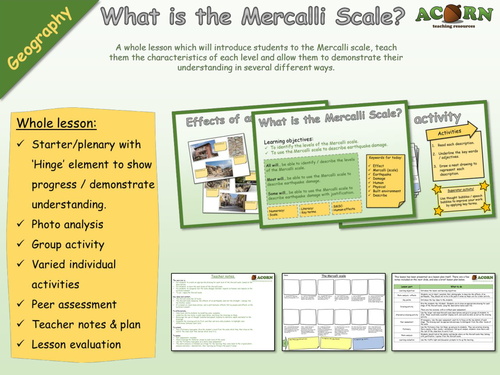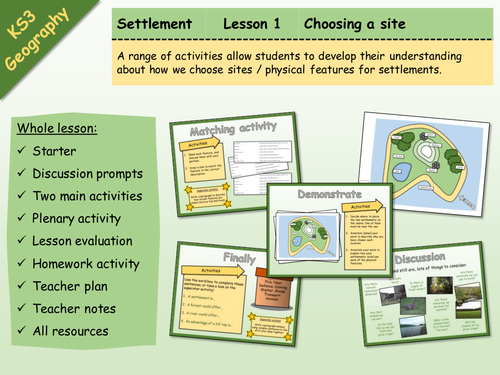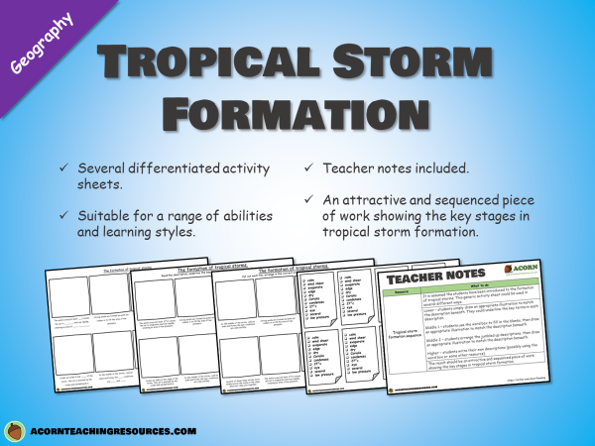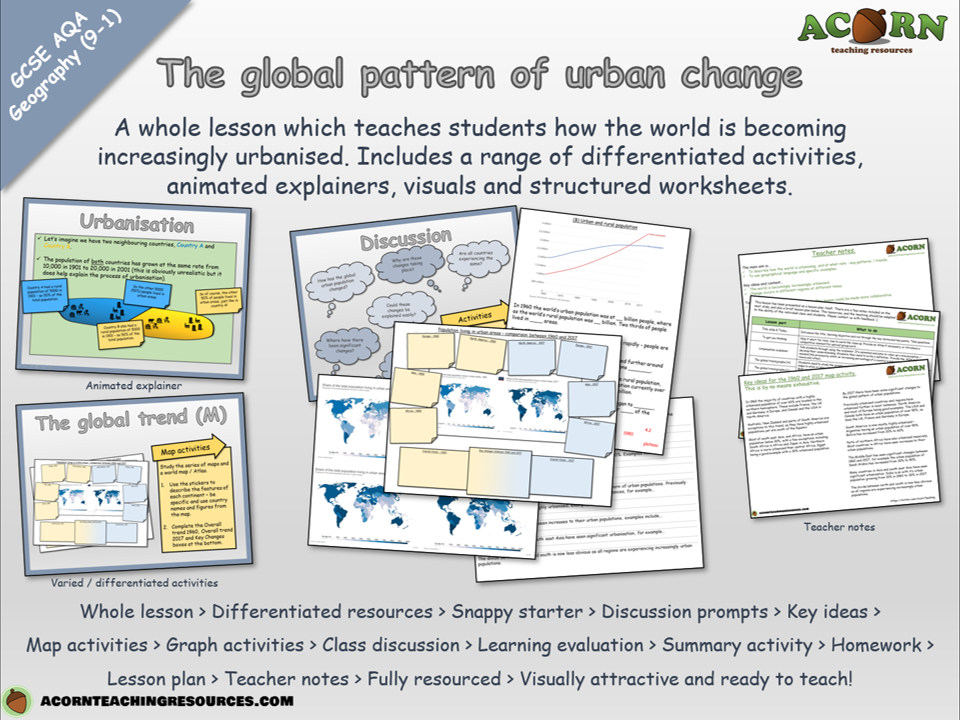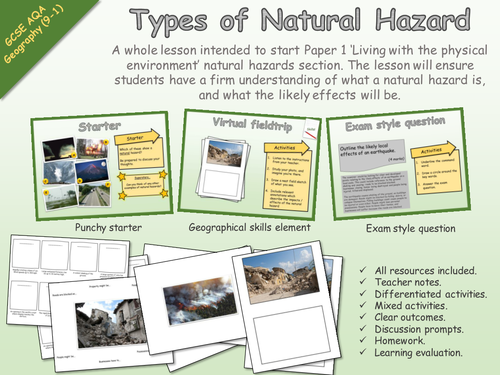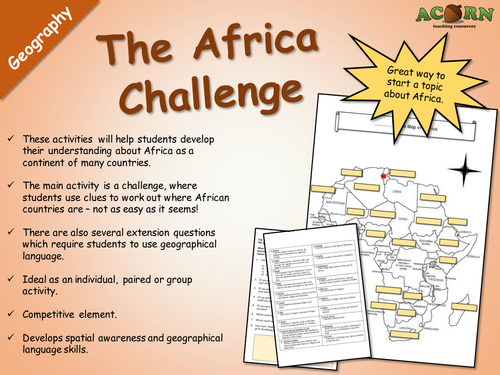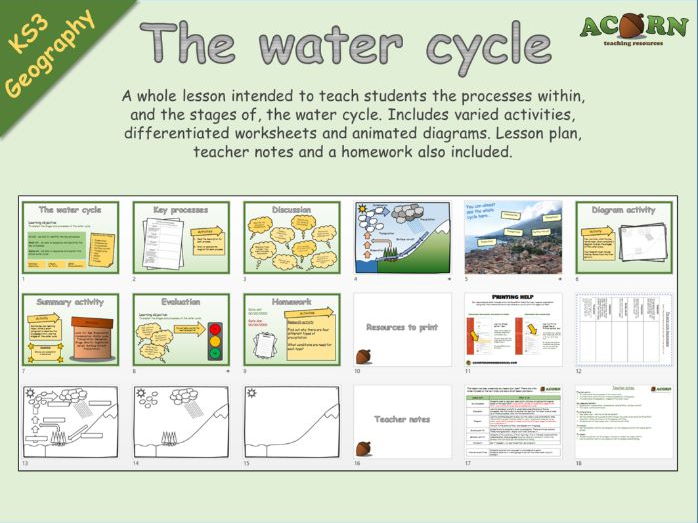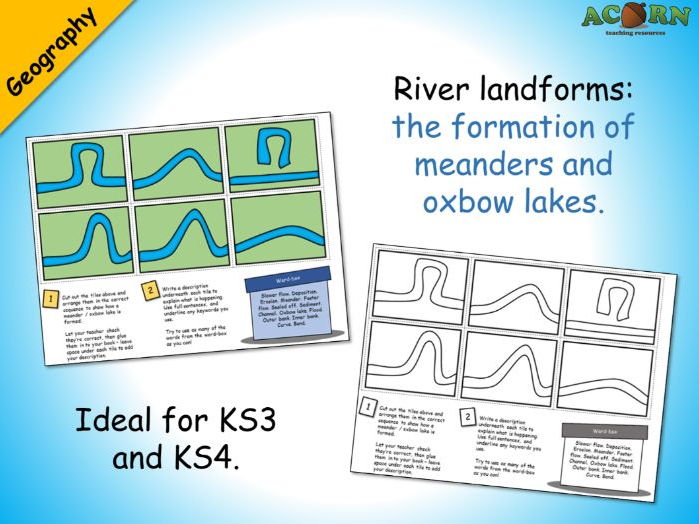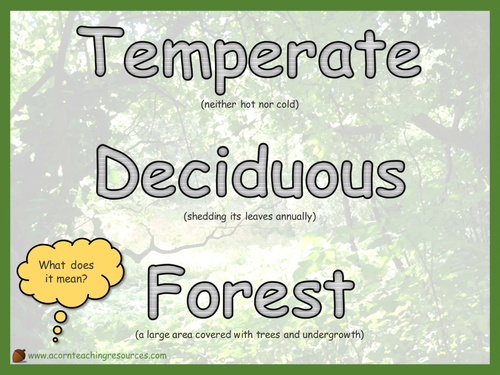66Uploads
140k+Views
52k+Downloads
Geography

Geography - Settlement Shapes (Whole lesson)
Geography - Settlement Shapes (Whole lesson)
A whole lesson with a range of differentiated activities aimed at teaching students the features of, and differences between; linear, nucleated and dispersed settlement shapes.
Includes: snappy starter, animated explainers, key points, class discussion, differentiated activities, assessment opportunities, a homework task and lesson evaluation. All resources are included, along with a lesson plan and teacher notes.
The main aim is…
For students to learn the features of, and differences between linear, nucleated and dispersed settlement shapes.
Key ideas and content…
Nucleated, linear and dispersed are all settlement shapes.
Settlements grow in different shapes for different reasons.
Nucleated settlements will grow around a feature.
Linear settlements will grow along a feature.
To differentiate…
There is differentiation in the lesson.
Provide the essential words for the summary activity.
Students could work on the photo analysis together.
To extend…
Use the superstar activities.
Get the maps out / photocopy and cut out to pick out actual settlement shapes.
To assess…
The photo analysis and the summary activity allow progress to be demonstrated and assessed.
The homework could also be assessed.
All reviews for our premium products have been 5/5* (As of 21st February 2017)

Geography - Natural Hazards - Earthquakes - Mercalli Scale drawing activity
A whole lesson which will introduce students to the Mercalli scale, teach them the characteristics of each level and allow them to demonstrate their understanding in several different ways.
Whole lesson:
Starter/plenary with ‘Hinge’ element to show progress / demonstrate understanding.
Photo analysis
Group activity
Varied individual activities
Peer assessment
Teacher notes & plan
Lesson evaluation
The main aim is…
For students to create an appropriate drawing for each level of the Mercalli scale, based on the descriptions.
For students to learn the main levels of the Mercalli scale.
For students to recognise how the scale changes between impacts on humans and impacts on the build environment.
To use / apply the Mercalli scale.
Key ideas and content…
The Mercalli scale has 12 levels.
The Mercalli scale measures the effects of an earthquake (and not the strength / energy like the Richter scale).
It is based on visual observations, and is split between effects felt by people and effects on the build environment.
To differentiate…
Help lower ability students by modelling some examples.
Underline the key terms in each description, and focus the drawings on these.
Encourage the use of thought bubbles and speech bubbles to add more depth and detail to the drawings.
Complete the drawing activity first, and then ask more able students to highlight main differences between each level.
To extend…
Play a Pictionary type game. Give the student a level from the scale which they then draw on the board. The class must then decide which level it is.
To assess…
Peer assessment included.
Check drawings for features unique to each level of the scale.
Use the Pictionary type game as a whole class assessment.
The photo analysis is intended as a Hinge for the learning, they come back to the original photo analysis and show / demonstrate their learning by filling in the post-it notes.

KS3 Geography - Settlement - 1 - Choosing a site
Whole lesson with all resources included.
Learning objective:
To learn why sites for settlements were chosen.
A range of activities allow students to develop their understanding about how we choose sites / physical features for settlements.
Whole lesson:
Starter
Discussion prompts
Two main activities
Plenary activity
Lesson evaluation
Homework activity
Teacher plan
Teacher notes
All resources

Measuring hurricanes
A range of activities with the aim of teaching students about the Saffir-Simpson hurricane wind scale.
Visually attractive, differentiated and fully resourced for a range of abilities.
Whole lesson: snappy starter, varied activities, key points, class discussion, assessment opportunities, a homework task and lesson evaluation. All resources included, along with lesson plan and teacher notes. This lesson has planned activities which show the teacher and the students their progress throughout.

Tropical storm formation - differentiated activity sheets
Several differentiated activity sheets.
Suitable for a range of abilities and learning styles.
Teacher notes included.
An attractive and sequenced piece of work showing the key stages in tropical storm formation.
This resource will help in the teaching of tropical storm formation at a range of ages and abilities.

Urban issues and challenges - The global pattern of urban change
AQA GCSE Geography - Unit 2 Section A - Urban issues and challenges - The global pattern of urban change
A whole lesson which teaches students how the world is becoming increasingly urbanised. Includes a range of differentiated activities, animated explainers, visuals and structured worksheets.
Whole lesson > Differentiated resources > Snappy starter > Discussion prompts > Key ideas >
Map activities > Graph activities > Class discussion > Learning evaluation > Summary activity > Homework > Lesson plan > Teacher notes > Fully resourced > Visually attractive and ready to teach!
The main aim is…
To describe how the world is urbanising, and at what rate - key patterns / trends.
To use geographical language and specific examples.
Key ideas and content…
The world is becomingly increasingly urbanised.
Change occurs in different regions at different times.
To differentiate…
Activities are mostly differentiated. This lesson could be made more collaborative in many areas to aid lower and middle ability students.
Model answers for higher students using L and M resources.

The Geography of Autumn
The Geography of Autumn gives students the opportunity to explore the interaction between people & environment and the Autumn season.
Students will apply atlas skills and explore interactions including: Autumn tourism, the impacts of global warming, animal migrations and cultural celebrations.
This is a structured and visually attractive lesson where the outcome is an informative piece of display work or a booklet. There are several ways the work could be completed over a range of time scales.

Geography - Map skills - Direction
Geography - Map skills - Direction
A complete lesson with a range of activities and resources aimed at teaching students how to use direction as a geographical skill. Students will apply the skill in several different ways as well as develop their spatial understanding of Europe.
Complete lesson > thoroughly resourced and ready to teach > snappy starter > explainers > SPaG activity > practise questions > varied map activities > peer assessment > summary activity > teacher notes > lesson plan > lesson evaluation > homework
The main aim is…
For students to learn / apply skills in describing direction.
To develop a spatial understanding of Europe.
Key ideas and content…
There are 8 points to the compass (as far as we’re concerned for today anyway)
We use direction to describe location / journeying.
Direction can be used by many different people in different situations.
To differentiate…
Students could take turns doing the countries / cities activities and then swap to help each other.
One student in a pair could have the map or atlas and act as an expert.
Pair up students when doing the map work.
To extend…
Use an OS map of the local area, Google Earth, an Atlas or online mapping to explore places.
Use the homework template and a local map / online mapping to explore geographical features in the local area (using direction obviously).
Certainly use the CYO task and encourage students to think about how they can test understanding / get students to apply map skills beyond simply describing.
To assess…
The road trip / CYO activity is the main assessment point.
Class discussion and the summary activity will also show progress and allow you to assess understanding.

KS3 Geography - Settlement - Problems and benefits of settlement growth
Whole lesson with all resources included.
Learning objective: To explore factors affecting quality of life in large settlements.
Whole lesson:
Starter
Discussion prompts
Two main activities
Plenary activity
Lesson evaluation
Homework activity
Teacher plan
Teacher notes
All resources

GCSE Geography - AQA - Living with the physical environment - Types of natural hazard
New 9-1 AQA Geography
Living with the physical environment
A whole lesson intended to start Paper 1 ‘Living with the physical environment’ natural hazards section. The lesson will ensure students have a firm understanding of what a natural hazard is, and what the likely effects will be.
All resources included.
Teacher notes.
Differentiated activities.
Mixed activities.
Clear outcomes.
Discussion prompts.
Homework.
Learning evaluation.

AQA Geography 9-1 Subject Specific Vocabulary - The challenge of natural hazards - Resources
Subject specific vocabulary resources
Section A: The challenge of natural hazards
A range of resources built around the AQA 9-1 Geography SSV for section A - The challenge of natural hazards.
Includes
- keyword bricks for display
- bingo game
- word mat
- teacher notes
All resources are included and are ready to print.
Keywords are grouped and colour coded.

Geography - The Africa Challenge
Ideal for KS3, but could be used with KS4. Introduce the continent of Africa and develop their spatial awareness of this massive continent.
These activities will help students develop their understanding about Africa as a continent of many countries.
The main activity is a challenge, where students use clues to work out where African countries are – not as easy as it seems!
There are also several extension questions which require students to use geographical language.
Ideal as an individual, paired or group activity.
Competitive element.
Develops spatial awareness and geographical language skills.
As of the 16th February, all of our premium resources have received a 5/5* review.

Geography - The Water Cycle
A whole lesson intended to teach students the processes within, and the stages of, the water cycle. Includes varied activities, differentiated worksheets and animated diagrams. Lesson plan, teacher notes and a homework also included.
The main aim is…
To understand the processes of the water cycle
To understand where and why these processes are taking place
To understand the sequence / stages of the water cycle
Key ideas and content…
Evaporation, transpiration, condensation, precipitation, surface run-off
The water cycle is continuous
To differentiate…
See lesson plan / use the varied worksheets
Get the students up in groups to talk through the water cycle using the PowerPoint animation – before moving on to the diagram activities
Students can act (see lesson plan – alternative activities)
To extend…
Set the summary activity as homework / or the research activity for higher ability groups
To assess…
Students could act out the stages – choose at random for higher ability.
Use the summary activity as a piece of work to assess understanding.
Every review we've received for a premium resource has been 5/5* (As of February 20th 2017)

River landforms - waterfall sequencing
Sequencing activity: River landforms - waterfalls
This is suited to KS3 but does work with KS4 - you'll need to add more detail (processes of erosion etc.).
There are four slides to help the teacher explain the processes involved and introduce the keywords.
The activity sheet requires students to complete three activities.
1. Cut out and arrange the tiles.
2. Add the labels from the sheet.
3. Add the descriptions from the sheet.
There is also an animated consolidation slide to allow teacher/students to check accuracy.
For higher ability - ask the students to underline the key terms, add more key terms and write their own descriptions.
Two version of the sheet are included; one in colour and one in outline black & white.
Every review we've received for a premium resource has been 5/5* (As of February 20th 2017)

Geography - Meanders and oxbow lakes activity
Ideal for KS3 and KS4. Could be used to teach or consolidate.
Six tiles are jumbled up on the sheet - the students need to cut these out and arrange them in the correct sequence. The next task is to write a description underneath each tile - there is a word-box to help the students explain each stage. Prior knowledge / understanding will be needed to complete.
Could be used as a mystery – see if students can work out why the oxbow lake formed before you explain.
Two version are included; one in colour and one in outline black & white.
Every review we've had for a premium resource has been 5/5* (As of February 21st 2017)

KS3 Geography - Weather & Climate - How weather influences shopping
A range of activities allow students to develop their understanding about how the weather can influence what we buy and when.
Whole lesson:
Starter
Two main activities
Plenary
Homework
Discussion prompts
Teacher notes
All resources
Mixed activities (sorting, drawing, discussion and writing)

Geography - Map skills - The Island - Assessment
Whole lesson / assessment - could be used to teach map skills or use as a stand alone assessment to use at the end of a map skills topic.
The assessment requires students to read a list of instructions and complete a map of 'The Island'. Students can show and develop their skills with grid references, distance, direction and map symbols.
The assessment element will show the teacher and student progress made, and also inform the student as to what they need to do to get to the next level.
There is an extra activity which then allows students to show their understanding about human and physical features, this could also make a good link to a tourism topic and incorporates literacy. Teacher notes and a brief lesson plan included with extension and differentiation notes.
This whole lesson is ready to go. All of our paid resources have received a 5/5* review as of 29th January 2017.

Geography - Display - Temperate Deciduous Forest definition
Print in A3 and stick on the wall somewhere.


